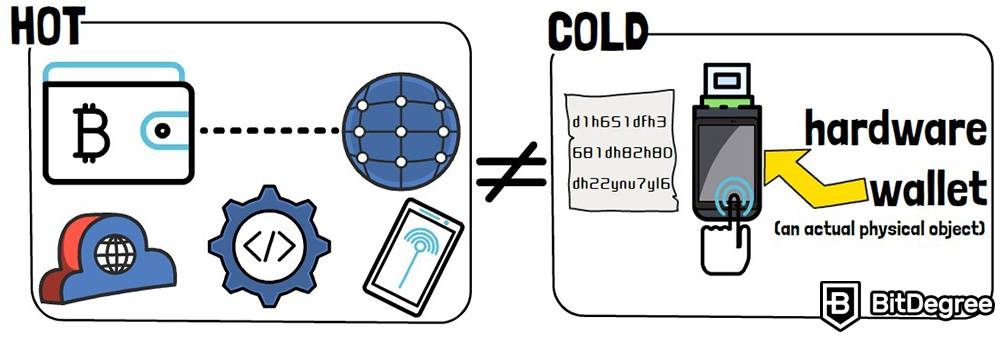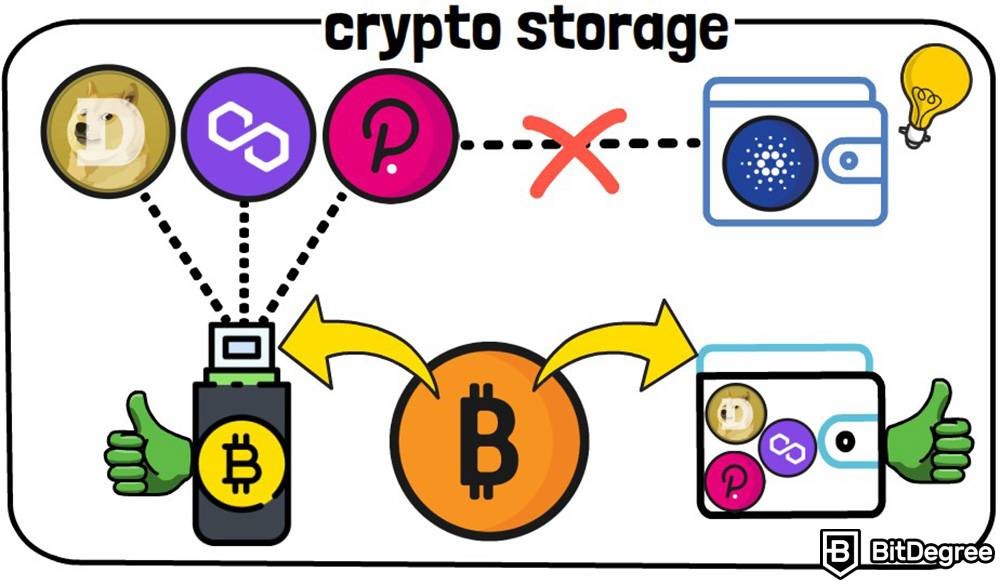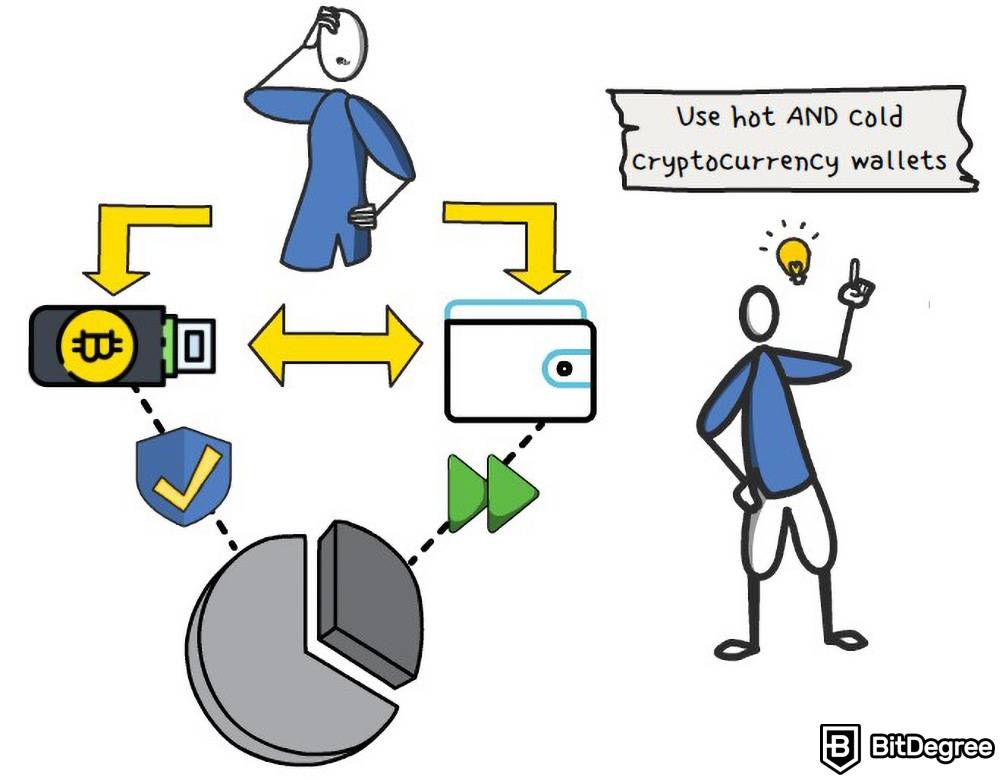Hot Wallet VS Cold Wallet: Which One to Pick?
In this section, we’re going to talk about the differences between hot wallets VS cold wallets!
Crypto wallets are a huge and exciting topic - in the previous section "What is a Crypto Wallet", I covered only the basic premise of what these wallets are, and how they work. One thing that we did touch on, though, was the different types of wallets out there - specifically, hot and cold ones.
The debate of hot VS cold crypto storage is neverending - if you’ve spent even a few days on online crypto forums, you might have noticed this already! If you’re new to the space, it can get pretty confusing - that’s what I’m here for, though!
In this section, we’re going to look into the century-old debate of hot wallets VS cold wallets. I’ll give you a brief introduction of what these two types of wallets are, to begin with, and then we’ll look into the pros and cons of using either of them. In the end, we’ll see if there’s a clear winner to be drawn!
Without further ado, let’s get to it!

Video Explainer
Video Explainer: Hot Wallet VS Cold Wallet: Which One to Pick?
Reading is not your thing? Watch the "Hot Wallet VS Cold Wallet: Which One to Pick?" video explainer
Hot VS Cold Wallet: Which One Do YOU Need? (Animated)


What are Crypto Hot and Cold Wallets?
Starting from the very beginning, let’s look into the actual concepts of hot and cold cryptocurrency wallets.
A great way to think about it is this: imagine that you and your friend agreed to meet up for coffee. Once you’re done catching up, you then decide to also go take a walk - before doing so, though, you need to pay for the coffee. The barista asks you - will you pay in cash, or via credit or debit card?
Paying in cash would mean that you’d take out your physical wallet, sort through your banknotes and coins, and pay this way. On the flip side, using your debit card, you’d simply swipe it through the machine, and your bank account would be charged that same amount.
Pretty simple, right? Well, hot wallets VS cold wallets aren’t much more difficult concepts to comprehend, either!

A cryptocurrency hot wallet is a crypto storage solution that maintains a constant, uninterrupted connection to the internet. These wallets are usually programs or pieces of software, but they can also be mobile apps, web browser-based platforms, and so on.
As opposed to that, cold wallets are either hardware devices, or even simply pieces of paper that have the private and public keys written on them. As a quick side note, if you’re not familiar with the concepts of wallet keys, in general, please make sure to read the previous section on crypto wallets, and how they work - this will help you understand the concepts covered in this section much better!
Going back to cold storage, hardware wallets are the most common type of cold cryptocurrency storage that you’ll encounter. Same as your standard wallet, hardware wallets are actual, physical objects, resembling small USB sticks, or some sort of a miniature digital display. You would usually operate these wallets with either a couple of buttons present on the device, or via a built-in touchscreen.
So, as you can see, both hot wallets VS cold wallets are somewhat similar, in the sense that they both offer crypto storage functionality to their users. This, however, is often where the similarities end, as well - apart from crypto storage, and a few other, smaller features, both wallet types are very different!
The Pros and Cons of Hot and Cold Wallets
Now, moving on, in order to understand the constant struggle that many crypto enthusiasts face, when it comes to picking out cold VS hot storage, we need to talk about those key differences and similarities between hot VS cold crypto wallets. This, in turn, will also reveal their specific pros and cons, as well - you’ll be able to evaluate them, and decide which wallet type suits your needs best!
Starting out, the obvious - crypto storage. Both hot VS cold wallets allow you to store cryptocurrencies - that’s their primary feature, after all. However, what you might not be aware of is that most hardware wallets will allow you to store hundreds, if not thousands of different coins and tokens!

Hot wallets are a bit more diverse. There are plenty of options for multiple asset storage, that’s true, but there are also many hot wallets that are coin-specific - meaning, you would only be able to store a single, designated crypto asset on the wallet.
Which option is better? Well, for most people, multiple asset storage will be the way to go. However, if you’re only going to hold a single coin or token, or if you’d like to use asset-specific wallets, in general, it’s good to know that such an option exists!
Another thing that both hot VS cold crypto wallets have in common are the additional services available from the wallet interface. For example, there are many hardware and software cryptocurrency wallets that have built-in crypto acquisition features - you are able to purchase cryptocurrencies straight from the wallet, without going out to an exchange!
As a side note, I do have to say - debating about hot wallets VS cold wallets involves understanding that buying crypto from within your wallet isn’t the safest thing to do, no matter what type of a wallet it is that you possess. Don’t fret, though - if you’re looking to buy crypto for the very first time, there's a dedicated section in this Crypto 101 Handbook covering the process, step-by-step - check it out!
Going back to the pros and cons of hot and cold crypto wallets, it’s time to address the “BIG” topic - the thing that sparks up the biggest debates among enthusiasts and crypto experts, alike. And that is the question of security VS convenience.

You see, since the dawn of the crypto industry, cryptocurrency wallets were viewed as the ultimate beacon of security - a place where you could store your assets, and not worry that they will get stolen. At least this SHOULD be the case - naturally, it puts wallet projects under a lot of scrutiny!
Following that, hot wallets have often been considered as the less-secure option, as far as hot and cold wallet comparisons go. This is because the fact that they are always connected to the internet - in theory, it makes them more susceptible to potential security breaches and hacking attempts.
On the flip side, hardware devices are usually disconnected from your computer, and thus, from the internet, in general. This makes reaching your private keys practically impossible, unless someone were to steal your actual wallet, or attack your account while you’re making a transaction.
Think of it like this - imagine that you live in a really densely-populated city, and need to go to work. Your work is on the other side of that city, and you have two options of transportation - either a bike, or a car.

A bike allows you to pass through traffic much quicker, saving you a lot of time and patience. With a car, you’d be stuck in traffic - however, cars are usually much safer to travel in!
This brings us to another point - convenience. Many enthusiasts believe that, where hot wallets are lackluster in security, they make up with the fact that they’re super-convenient to use. Cold wallets, while being very secure, can be a headache to operate, if you plan on transacting with crypto a few times per day or so.
Which is Better?
All of that leads us to the final question - which one should you pick? Or, in other words, comparing a hot wallet VS a cold wallet, which option is better?
Well, let me tell you - you DON'T actually need to pick and choose, in the first place.

The easiest way to avoid any and all difficult debates and discussions, as well as cold wallet VS hot wallet comparisons, is to use at least two cryptocurrency wallets - one hot, and one cold. You would then store the bigger part of your portfolio in the hardware wallet (since it’s considered to be the safer alternative), and use the smaller amount for trading and transaction purposes (since it’s more convenient).
Naturally, very generally speaking, the more wallets you utilize, the better. This will allow you to diversify your risk, and if something were to happen to one of the wallets, you wouldn’t suffer any major losses. But, if you at least choose to use both hardware and software wallets, instead of comparing and contrasting hot VS cold wallets, this is already a move in the right direction!
One last thing that’s worth mentioning is that the cryptocurrency wallet industry is growing and evolving, together with the rest of the space. While the stigma attached to hot wallets not being the most secure crypto storage solution is still alive and common, as time goes on, this is something that’s slowly fading away, as well.
That being said, potential scammers and foul players are keeping up with the times, as well. Make sure to educate yourself about some of the most common crypto scam attempts, and focus on the best hot and cold cryptocurrency wallet practices!










